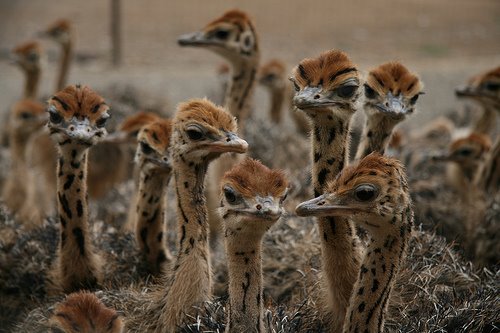Production Facts
Ostrich production is the key to reaching the goal of commercial production. Ostrich hens can lay anywhere from 20-120 eggs per season, but the average in Canada is between 30-60. Our season generally runs from February/March to September/October. Climate, diet and the general well being of the birds will determine the production and fertility of eggs. The hens may start to lay as early as 2 years but are not considered mature until 4 to 5 years of age and at this age should be a consistent layer. Hens will lay an egg every other day until her clutch is depleted (10-15 eggs) and rest for a few days, then start laying again. Fertility rate can vary from 50% to 100%. The average is 80%.
Hatchability
The hatchability figures will vary from producer to producer. Proper nutrition is a key part of management and can have a major impact on the operation. With experience, proper incubation parameters and health conditions of breeding stock, hatch-ability as high as 80-90% of fertile eggs can be achieved.
Survivability
The survivability of chicks depends largely on management practices. Mortality of chicks averages 10%, but this figure will decrease as we learn more about raising these birds through research and development. Mortality may be higher in larger operations as compared to smaller operations with one or two breeding pairs. An average of 20-30 chicks can be raised to processing age from one laying hen. These figures will vary from farm to farm.
Processing Age
The age to process is generally determined by body size, a circumference of 110-112cm around the chest (in front of the wings) is considered an ideal size. This gives a hide that is 12-14 square feet in size. Birds are generally in the 200lb. to 240lb. range live weight at slaughter age. After processing, this will yield 90 -100 lb. of edible deboned lean meat. Processing age should be 12-14 months.
http://www.ostrich.ca/manual/index.htm#survive
Wednesday, April 30, 2008
QUICK FACTS
- The Ostrich is the largest living bird in the world.
- It is of the Ratite family, which means flightless bird.
- The Ostrich is native to Africa, yet thrives in countries all over the world.
- Adult males are eight to ten feet in height and weigh 350-400 pounds.
- A male Ostrich is called a rooster and a female Ostrich is called a hen.
- The male is black with white wing tips and tail plumes.
- The female has light brown and grey plumage and is slightly smaller than the male.
- This great bird has two toes, all other birds have three or four toes.
- The Ostrich can run at speeds of up to 40 MPH for sustained times.
- An Ostrich will live to be 50 - 75 years old.
- Although an ostrich egg is the largest of all eggs, it is the smallest egg in relation to the size of the bird. The Ostrich egg will weigh 1600 gm and is equivalent to 2 dozen chicken eggs.
- An Ostrich Hen can lay 40 -100 eggs per year, averaging about 60 eggs per year.
- Ostrich eggs hatch in 42 days.
- An Ostrich chick grows one foot taller each month until it is 7-8 months old.
- Females sit on eggs by day; males sit on eggs by night.
- To soft boil a fresh egg would take one hour.
- To hard boil would take 1 1/2 hours.
- Ostrich farming is a viable alternative agriculture industry, with fine quality leather, feathers and gourmet meat as the principal products.
RAISING BIG BIRDS
Growing as tall as 2.7m, the ostrich is the largest living bird on the planet, weighing up to 130kg (285lbs). It is also one of the fastest two-legged creatures, with the ability to hit speeds of 65km per hour.
In northern Africa and Arabia, people would race on ostriches as they would horses. So let’s make this clear: owning an ostrich is quite different from looking after a backyard fighting cock! Especially if you have 600 of them – which is the number of ostriches Big Bird has on its farm at any given time.
In order to raise the big birds, the farm needed to be large enough to have areas for them to roam about, especially when they reach maturity. The birds also have to be kept in separate pens according to their age, so the right fencing and layout were also necessary. Those who remember their biology would know that the ostrich arrives in the form of an egg.And ostrich eggs are huge! They are about the size and weight of an American football.
At the Big Bird Farm, there is a medium-sized steel building devoted to incubation. The eggs hatch after 42 days, and the chicks are then kept in sheltered pens for eight weeks. Measuring 10 inches in length and weighing about two pounds, they might not seem particularly fragile, but this is the time when the most mortalities occur, so the utmost care is given.
Subscribe to:
Posts (Atom)


